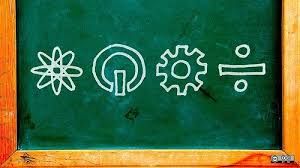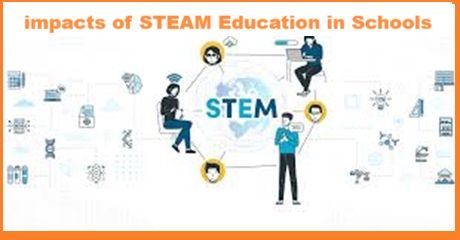Introduction:
lmpacts of STEAM Education in Schools stands out as a beacon of creativity, integrating Science, Technology, Engineering, Arts, and Mathematics into a cohesive framework that fosters holistic learning and cultivates essential skills for success in the 21st century. It emphasizes real-world applications, creativity, critical thinking, and problem-solving skills, preparing students for success in an increasingly complex and interconnected world.
STEAM education seeks to break down the traditional silos between subjects, recognizing the interconnectedness of knowledge and the importance of interdisciplinary thinking. By incorporating the arts into STEM (Science, Technology, Engineering, and Mathematics) disciplines, STEAM education encourages students to approach problems from multiple perspectives, fostering innovation and creativity. It also promotes equity and inclusion by providing opportunities for all students to engage with STEM and the arts, regardless of their background or abilities. By creating a supportive and inclusive learning environment. Its aims to inspire and empower the next generation of scientists, engineers, artists, and innovators from diverse backgrounds.

Fostering Creativity and Innovation
At the core of STEAM education lies a commitment to nurturing creativity and innovation. By integrating the arts into STEM disciplines, students are encouraged to explore, experiment, and think outside the box. Whether they’re designing a new invention, composing a piece of music inspired by scientific concepts, or creating a digital artwork, STEAM empowers students to unleash their imagination and harness the power of innovation.
Interdisciplinary Learning: Connecting the Dots
Gone are the days of compartmentalized learning, where subjects were taught in isolation. In the STEAM classroom, boundaries blur as students explore the interconnectedness of knowledge. Through interdisciplinary projects and activities, they discover the symbiotic relationship between different disciplines, gaining a deeper understanding of how concepts intersect and overlap in the real world.
Hands-On Exploration: Learning by Doing
STEAM education is synonymous with hands-on, experiential learning. From building robots to conducting science experiments to creating multimedia presentations, students actively engage with concepts and ideas, transforming theoretical knowledge into practical skills. This immersive approach not only enhances retention but also fosters a love for learning that extends far beyond the classroom walls.
Empowering Collaboration: The Power of Teamwork
Collaboration lies at the heart of STEAM education, reflecting the collaborative nature of innovation in the real world. Through group projects and cooperative activities, students learn to communicate effectively, share ideas, and work towards common goals. By harnessing the collective intelligence of the group, they discover the power of synergy, achieving outcomes that surpass individual efforts.
Real-World Relevance: Bridging Theory and Practice
One of the defining features of STEAM education is its emphasis on real-world relevance. By connecting learning to authentic, meaningful experiences, students gain a deeper appreciation for the practical applications of their knowledge. Whether they’re designing sustainable solutions to environmental challenges or using technology to address social issues. STEAM education empowers students to make a positive impact on the world around them.
Cultivating Critical Thinking: Nurturing Analytical Skills
Critical thinking lies at the heart of STEAM education, empowering students to question, analyze, and evaluate information critically. Through inquiry-based learning and problem-solving activities, students develop the skills they need to navigate complex challenges with confidence and resilience. Additionally, it fostering a spirit of curiosity and inquiry, STEAM education cultivates lifelong learners who are equipped to thrive in an ever-changing world.
Diversity and Inclusion: Celebrating Unique Perspectives
STEAM education celebrates diversity and inclusion, recognizing the value of different perspectives and experiences. By fostering an inclusive learning environment where all students feel valued and respected. STEAM education promotes equity and access for all. Although, projects that highlight diverse voices and cultures, students gain a deeper understanding of the rich tapestry of human experience. Preparing them to engage with empathy and understanding in an increasingly globalized world.
Empowering the Innovators of Tomorrow
As we look to the future, the role of STEAM education in schools has never been more critical. By fostering creativity, collaboration, critical thinking, and real-world relevance. STEAM education equips students with the skills they need to thrive in a rapidly changing world. Finally, From igniting a passion for learning to empowering students to become the innovators and leaders of tomorrow. STEAM education paves the way for a brighter, more inclusive future for all.

41dsyx
ykot8x
Hi , I do believe this is an excellent blog. I stumbled upon it on Yahoo , i will come back once again. Money and freedom is the best way to change, may you be rich and help other people.
7dxt2s
Platform Slot Gacor yang Membayar Besar dan Tepat Waktu, hanya di SIGMASLOT
o1nb8a
This all-in-one clock radio CD player is more than just an alarm—it’s a full media hub. Along with a traditional CD player, it features AM/FM radio, Bluetooth connectivity, and a wireless remote control. Dual alarms make it easy to set different wake times, while the large LED display ensures easy readability. With rich stereo sound and multiple playback options, it’s one of the best clock radios with CD player and Bluetooth functionality. Great for music lovers who value versatility in a radio alarm clock CD player setup.
биржа аккаунтов магазин аккаунтов
безопасная сделка аккаунтов платформа для покупки аккаунтов
магазин аккаунтов магазин аккаунтов
услуги по продаже аккаунтов услуги по продаже аккаунтов
площадка для продажи аккаунтов https://prodat-akkaunt-online.ru/
заработок на аккаунтах https://kupit-akkaunt-top.ru/
продажа аккаунтов соцсетей https://pokupka-akkauntov-online.ru/
Account Trading Platform Account marketplace
Account trading platform Sell Pre-made Account
Social media account marketplace Sell Pre-made Account
Marketplace for Ready-Made Accounts Account Purchase
Ready-Made Accounts for Sale Website for Buying Accounts
Account Trading Account Sale
Marketplace for Ready-Made Accounts Buy and Sell Accounts
Account Purchase Account Selling Service
Account Buying Platform Sell accounts
Account Trading Platform https://accountsmarketplaceonline.com/
Buy Pre-made Account socialmediaaccountsale.com
accounts market account market
buy accounts account acquisition
account buying platform sell pre-made account
account sale website for selling accounts
account sale database of accounts for sale
accounts for sale sell account
secure account sales sell accounts
marketplace for ready-made accounts sell account
gaming account marketplace accounts marketplace
website for selling accounts account buying service
accounts marketplace buy account
sell pre-made account buy account
account exchange service social media account marketplace
marketplace for ready-made accounts sell accounts
sell pre-made account website for selling accounts
secure account purchasing platform gaming account marketplace
profitable account sales gaming account marketplace
secure account sales find accounts for sale
gaming account marketplace account selling platform
sell account accounts for sale
sell accounts accounts market
account market find accounts for sale
online account store website for selling accounts
account acquisition account acquisition
gaming account marketplace secure account purchasing platform
sell pre-made account account acquisition
gaming account marketplace sell pre-made account
purchase ready-made accounts account trading platform
social media account marketplace https://accounts-offer.org
buy pre-made account https://buy-best-accounts.org
buy accounts https://accounts-marketplace.xyz/
sell account https://social-accounts-marketplaces.live/
online account store https://accounts-marketplace.live
accounts for sale https://social-accounts-marketplace.xyz
account catalog https://buy-accounts.space
account market https://buy-accounts-shop.pro
sell pre-made account accounts-marketplace.art
account market https://social-accounts-marketplace.live
accounts for sale https://buy-accounts.live
website for buying accounts https://accounts-marketplace.online
buy pre-made account https://accounts-marketplace-best.pro
покупка аккаунтов https://kupit-akkaunt.xyz
покупка аккаунтов магазины аккаунтов
площадка для продажи аккаунтов https://rynok-akkauntov.top
маркетплейс аккаунтов https://akkaunty-market.live
маркетплейс аккаунтов соцсетей https://akkaunt-magazin.online/
продажа аккаунтов kupit-akkaunty-market.xyz
маркетплейс аккаунтов https://akkaunty-optom.live/
купить аккаунт https://online-akkaunty-magazin.xyz
магазин аккаунтов akkaunty-dlya-prodazhi.pro
покупка аккаунтов https://kupit-akkaunt.online/
buy facebook advertising accounts buy facebook ads account
buy aged facebook ads account buy facebook accounts for advertising
buy fb ads account facebook account buy
buy facebook ads account https://buy-ads-account.click/
buy facebook advertising accounts https://ad-account-buy.top
buy facebook old accounts https://buy-ads-account.work
buy facebook ads manager https://ad-account-for-sale.top
cheap facebook advertising account buy-ad-account.click
Эта публикация завернет вас в вихрь увлекательного контента, сбрасывая стереотипы и открывая двери к новым идеям. Каждый абзац станет для вас открытием, полным ярких примеров и впечатляющих достижений. Подготовьтесь быть вовлеченными и удивленными каждый раз, когда продолжите читать.
Детальнее – https://medalkoblog.ru/
buy facebook accounts cheap https://ad-accounts-for-sale.work
buy facebook old accounts https://buy-accounts.click
old google ads account for sale https://buy-ads-account.top
buy google ads verified account https://buy-ads-accounts.click
buy google ads invoice account google ads accounts for sale
buy google ads accounts https://ads-account-buy.work
buy aged google ads accounts https://buy-ads-invoice-account.top
buy google ads threshold accounts https://buy-account-ads.work
buy aged google ads accounts https://buy-ads-agency-account.top
buy old google ads account https://sell-ads-account.click
buy google ad account https://buy-verified-ads-account.work
buy google ads verified account https://ads-agency-account-buy.click/
buy verified bm facebook https://buy-business-manager.org
buy verified bm https://buy-bm-account.org
buy fb business manager https://buy-business-manager-acc.org
buy facebook business managers https://buy-verified-business-manager-account.org/
buy verified facebook https://buy-verified-business-manager.org
buy verified bm facebook buy-bm.org
unlimited bm facebook https://business-manager-for-sale.org
buy business manager facebook https://buy-business-manager-verified.org/
buy facebook business account verified-business-manager-for-sale.org
buy facebook business manager verified https://buy-business-manager-accounts.org/
tiktok ads account buy https://buy-tiktok-ads-account.org
tiktok ads account for sale https://tiktok-ads-account-buy.org
tiktok ads account buy https://buy-tiktok-ad-account.org
buy tiktok ads accounts https://tiktok-ads-account-for-sale.org
tiktok ads account for sale https://tiktok-agency-account-for-sale.org
tiktok ads account for sale https://buy-tiktok-ads-accounts.org
tiktok ads account for sale buy tiktok ads
tiktok ads account buy https://buy-tiktok-business-account.org
tiktok ads account buy https://tiktok-ads-agency-account.org
Great site. A lot of helpful information here. I am sending it to several buddies ans also sharing in delicious. And certainly, thanks for your sweat!
buy facebook accounts account store verified accounts for sale
This was a very informative post. I appreciate the time you took to write it.
You’ve done a great job with this. I ended up learning something new without even realizing it—very smooth writing!
Your advice is exactly what I needed right now.
Such a refreshing take on a common topic.
This was so insightful. I took notes while reading!
You bring a fresh voice to a well-covered topic.
This is now one of my favorite blog posts on this subject.
I love how well-organized and detailed this post is.
Thanks for addressing this topic—it’s so important.
I appreciate the real-life examples you added. They made it relatable.
Great article! I’ll definitely come back for more posts like this.
This helped clarify a lot of questions I had.
You’ve done a great job with this. I ended up learning something new without even realizing it—very smooth writing!
Thank you for making this topic less intimidating.
You write with so much clarity and confidence. Impressive!
The way you write feels personal and authentic.
I feel more confident tackling this now, thanks to you.
I hadn’t considered this angle before. It’s refreshing!
This was really well done. I can tell a lot of thought went into making it clear and user-friendly. Keep up the good work!
What a great resource. I’ll be referring back to this often.
This helped clarify a lot of questions I had.
This content is gold. Thank you so much!
I love how practical and realistic your tips are.
buy facebook accounts cheap purchase ready-made accounts profitable account sales
So simple, yet so impactful. Well written!
Very useful tips! I’m excited to implement them soon.
Your thoughts are always so well-organized and presented.
You made some excellent points here. Well done!
o04464
coph88
7ak2t7
vn8vnr
I have been absent for a while, but now I remember why I used to love this web site. Thank you, I¦ll try and check back more often. How frequently you update your web site?
I’m really enjoying the theme/design of your site. Do you ever run into any internet browser compatibility issues? A couple of my blog visitors have complained about my website not operating correctly in Explorer but looks great in Firefox. Do you have any suggestions to help fix this problem?
I’d constantly want to be update on new articles on this web site, saved to fav! .
I’ve recently started a website, the information you offer on this website has helped me greatly. Thank you for all of your time & work. “Money is power, freedom, a cushion, the root of al evil, the sum of all blessings.” by Carl Sandburg.
Really instructive and great bodily structure of content, now that’s user pleasant (:.
You have brought up a very excellent points, thanks for the post.
Hi my friend! I wish to say that this post is amazing, nice written and include approximately all important infos. I would like to see more posts like this.
I envy your work, thankyou for all the interesting posts.